Alongside the 20-year decline in earnings paid to workers, Alabama’s auto companies also are falling short by paying staggeringly unequal wages across race and gender lines. Men earn significantly more than women, and white workers earn significantly more than Black and Hispanic workers. These pay gaps are driven largely by occupational segregation: the fact that Black, Hispanic and female workers are disproportionately employed in lower–wage occupations within the auto industry than white workers and men, who tend to be over-concentrated in higher-wage occupations.
Men and white workers earn more than women and workers of color
Alabama has stunning gaps in pay between white autoworkers and autoworkers of other races, as seen in Figure 5.1. In 2019, white autoworkers earned an average $68,595, almost $12,000 more than Black autoworkers and $15,000 more than Hispanic autoworkers. As a result, a Black autoworker earns on average 83 cents for every dollar earned by a white autoworker. For Hispanic autoworkers, it’s 78 cents for every dollar earned by a white autoworker.
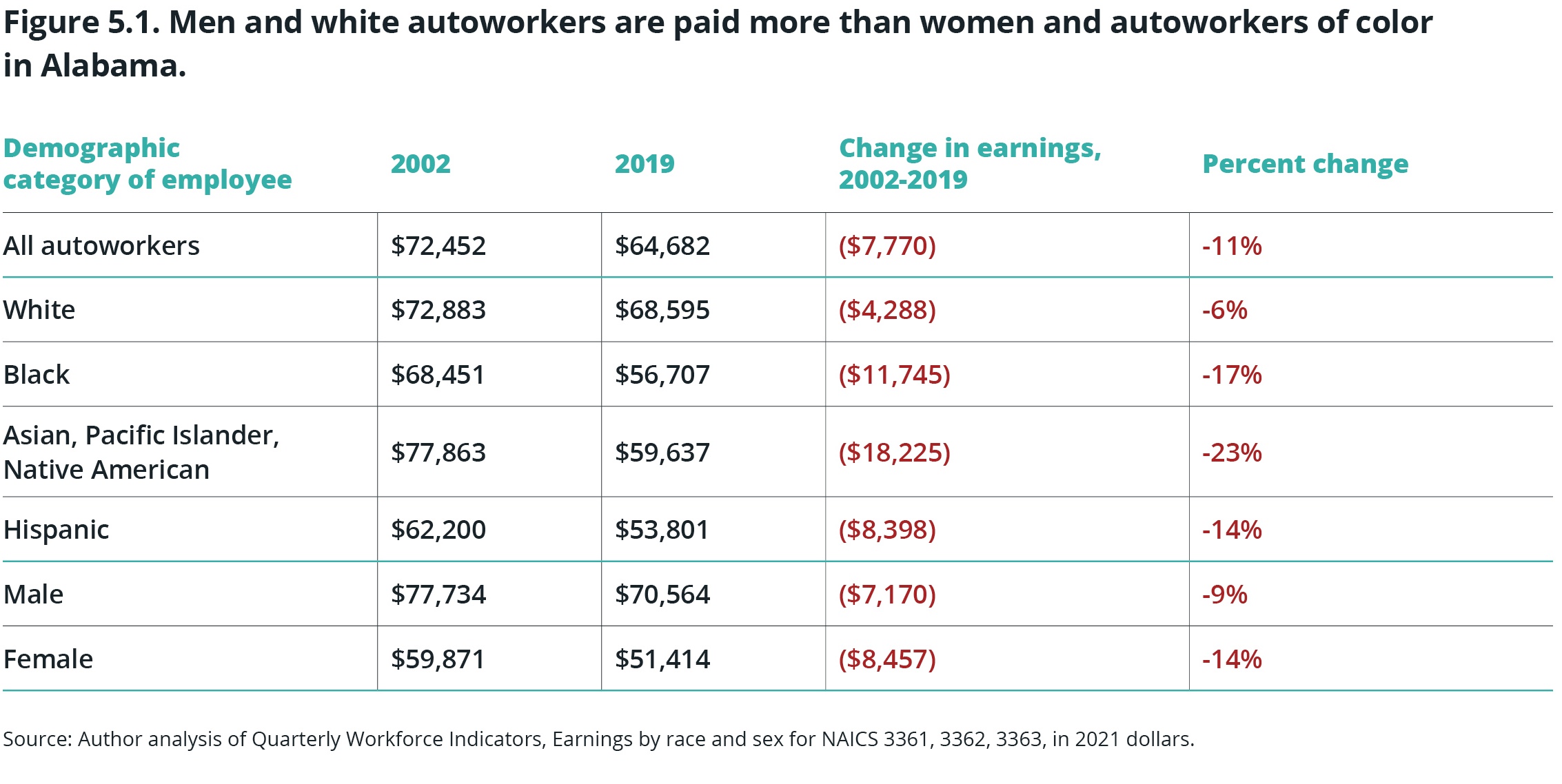
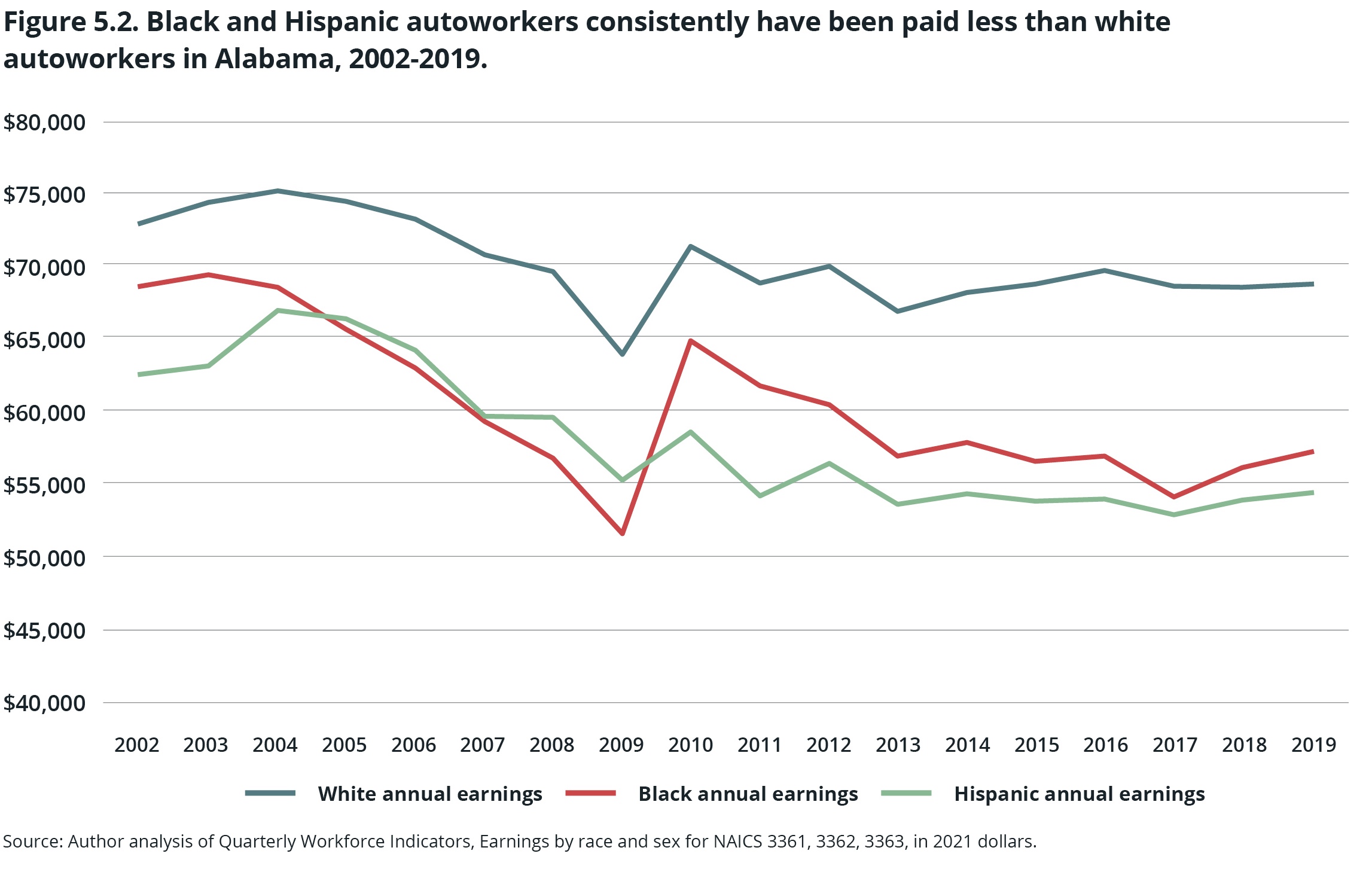
Even more troubling, wages for Black and Hispanic autoworkers have declined further and faster than wages for white autoworkers since 2002. While white workers earn $4,288 on average less today than they did 20 years ago (a 6% drop), Hispanic workers in the industry have seen their wages drop by an average of $8,398 (a 14% decline). Black autoworkers on average lost almost $12,000 in earnings since 2002 (a 17% decline). So not only do they earn less than white workers today, but these workers of color also have lost significantly more pay over the past 20 years than their white counterparts.[74]
The auto industry is paying men and women significantly different wages, too. In 2019, the state’s auto companies paid men an average annual wage of $70,564 – almost $20,000 more than the $51,414 average annual wage they paid women. As a result, women earned just 73 cents for every dollar earned by men. Unfortunately, women’s pay is also dropping faster than men’s. In 2019, women earned on average $8,457 less than they did in 2002 – a 14% drop. By contrast, men’s auto wages fell by 9% over the same period.
Occupational segregation drives racial and gender pay gaps in the auto industry
As in Alabama’s overall economy, the state’s auto industry is highly segregated by race and sex. Occupational segregation occurs when workers in one racial or gender group are overrepresented or underrepresented in a particular occupation or job role compared to their share of the broader population of industry employees. When one group is persistently overrepresented in high-wage occupations, while another group is overrepresented in low-wage occupations and underrepresented in high-wage occupations, we can say there is a clear pattern of occupational segregation.
Unfortunately, Alabama’s auto industry displays a pattern of deep and pervasive occupational segregation. White workers and men are generally overrepresented in the highest-wage occupations, while Black workers and women are more heavily concentrated in the industry’s lowest-paying occupations. A stubborn legacy from the era of legalized discrimination and industrialization across the South, this pattern of occupational segregation among auto employees is likely still the driving force behind the pervasive unequal pay between white workers and Black workers and – to a lesser but still meaningful extent – between men and women in the industry.[75]
By the numbers, white workers dominate the highest–wage occupations in the auto industry, especially first-line supervisors, who earn on average $91,805 every year. While they account for barely half of workers in the industry, white employees make up 63% of higher-paid supervisors and executives. The welding and soldering occupation (which pays an average of $65,128 every year) tells a similar story. White workers account for 54% of these jobs.
Black workers are significantly underrepresented in the better-paid supervisor occupation, making up 35% of those employees. In addition, as seen in Figure 5.3, they are also increasingly overrepresented in the lowest-paid occupations, which earn below the industry average ($64,682 a year). Black workers account for 41% of all autoworkers, but make up:
- 58% of inspectors and weighers, who earn on average $60,450 a year.
- 62% of miscellaneous assemblers and fabricators, who earn an average $53,401 a year.
- 59% of general laborers, who earn on average $52,612 a year.
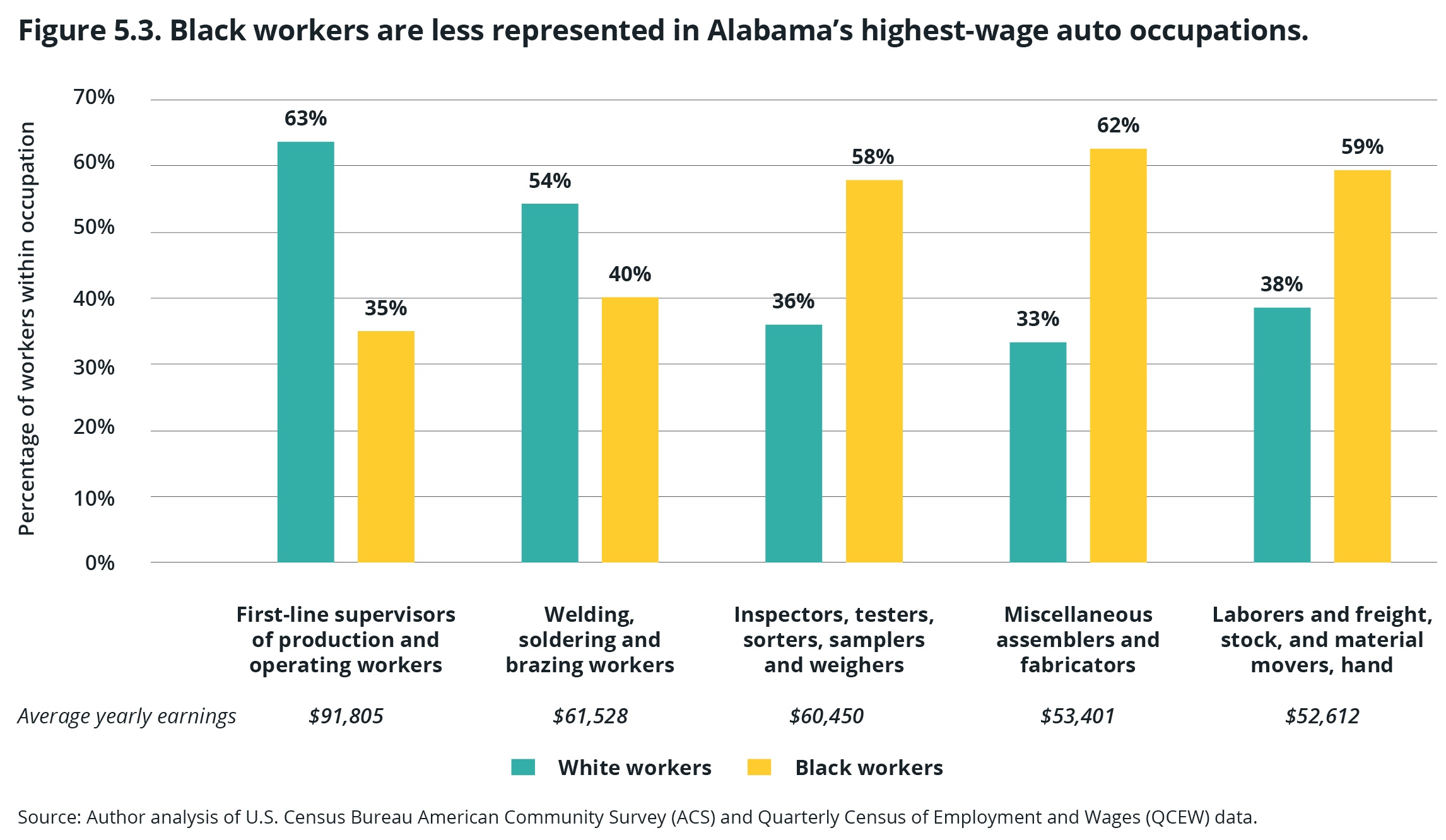
 Women in the auto industry face a broadly similar challenge with occupational segregation. As seen in Figure 5.4, roughly one out of every three autoworkers in Alabama is a woman, yet women account for almost half of all employees in two occupations that pay below-average wages – inspectors and weighers; and miscellaneous assemblers – and more than 35% of general laborers, stock and material movers, the lowest–paid occupation in the auto industry. Complicating the picture slightly, women are overrepresented in the highest-wage occupation, first-line supervisors, which is a positive sign. But they are significantly underrepresented in the second highest-paying occupation, welding, where they account for just 18% of employees.
Women in the auto industry face a broadly similar challenge with occupational segregation. As seen in Figure 5.4, roughly one out of every three autoworkers in Alabama is a woman, yet women account for almost half of all employees in two occupations that pay below-average wages – inspectors and weighers; and miscellaneous assemblers – and more than 35% of general laborers, stock and material movers, the lowest–paid occupation in the auto industry. Complicating the picture slightly, women are overrepresented in the highest-wage occupation, first-line supervisors, which is a positive sign. But they are significantly underrepresented in the second highest-paying occupation, welding, where they account for just 18% of employees.
In short, women are clustered mostly in lower–wage occupations, but as the industry hires more women in the coming years, an opportunity exists to move them into higher-earning roles within each company. Certainly, the industry should view with concern the fact that female autoworkers earn just 73 cents for every dollar earned by a man in the industry.
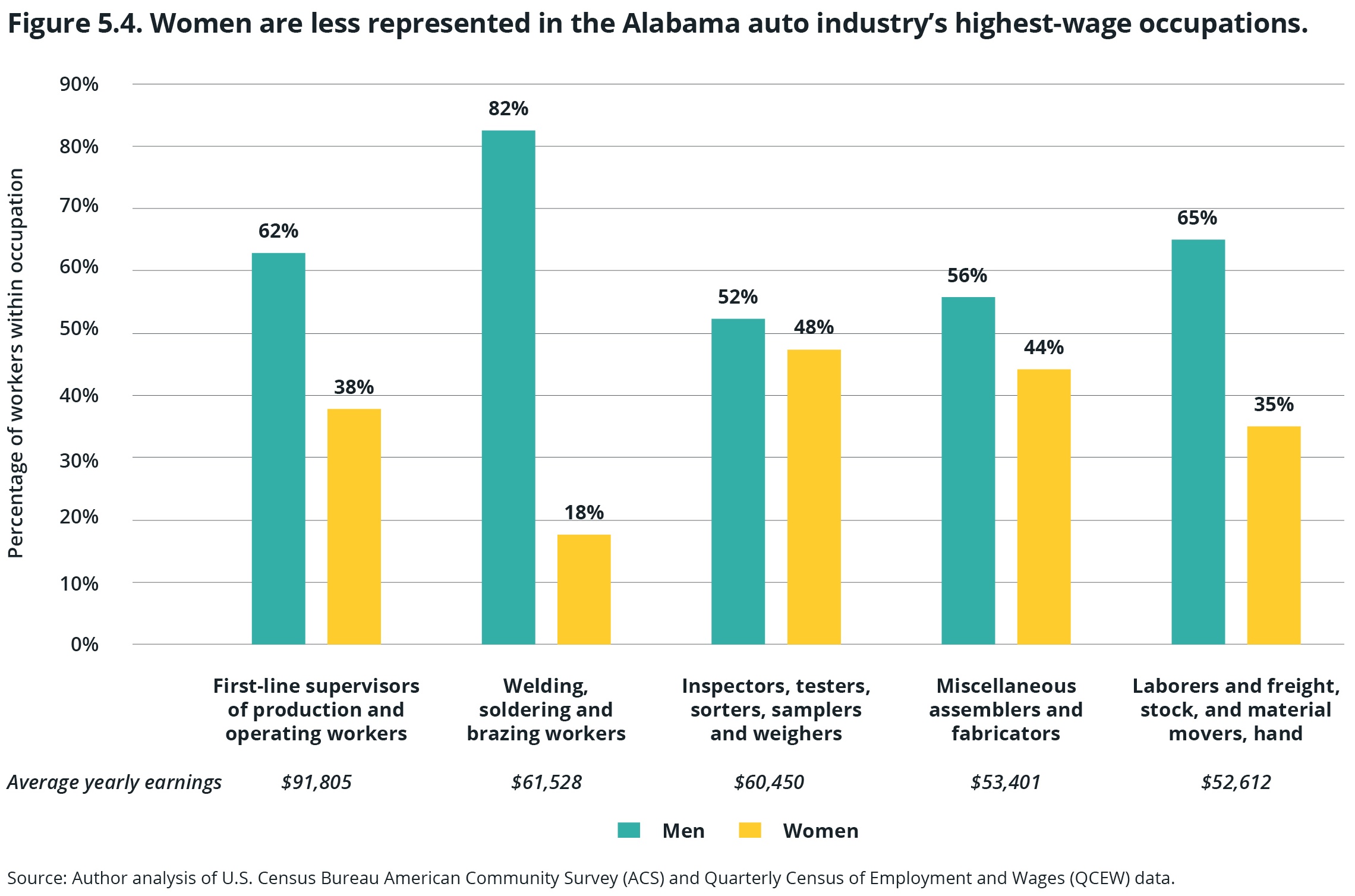
Historical origins of occupational segregation and the auto industry wage gap
Why are women and Black workers in Alabama’s auto industry today living with this kind of occupational segregation when the era of legalized racial and gender discrimination ended half a century ago? Historically, the brutal, dehumanizing system of state-sanctioned slavery forced African Americans to work without pay in occupations like agriculture, general labor and domestic service and deemed them to be the “property” of white enslavers.[76] When slavery ended and Jim Crow-era segregation began, Black people were no longer considered property by law, but they often were forced to work in the same occupations as they had in the slavery era, barred by legally sanctioned (and sometimes legally mandated) discrimination from majority–white professions and occupations that paid better wages.[77]
Even as late as the 1950s, Alabama’s economic development officials built their industrial recruitment efforts around the explicit goal of “creating jobs for white men” – good-paying jobs available for white workers coming off the farm as the mechanization of agriculture reduced the need for farm labor.[78] Though some African Americans succeeded in breaking into middle–class and professional occupations, legal and societal barriers forced most Black workers into sharecropping if they stayed on farms, or if they left, into the lowest-wage occupations on and off the factory floor.[79] In turn, this kept African Americans locked into low–wage jobs with little opportunity for advancement.[80]
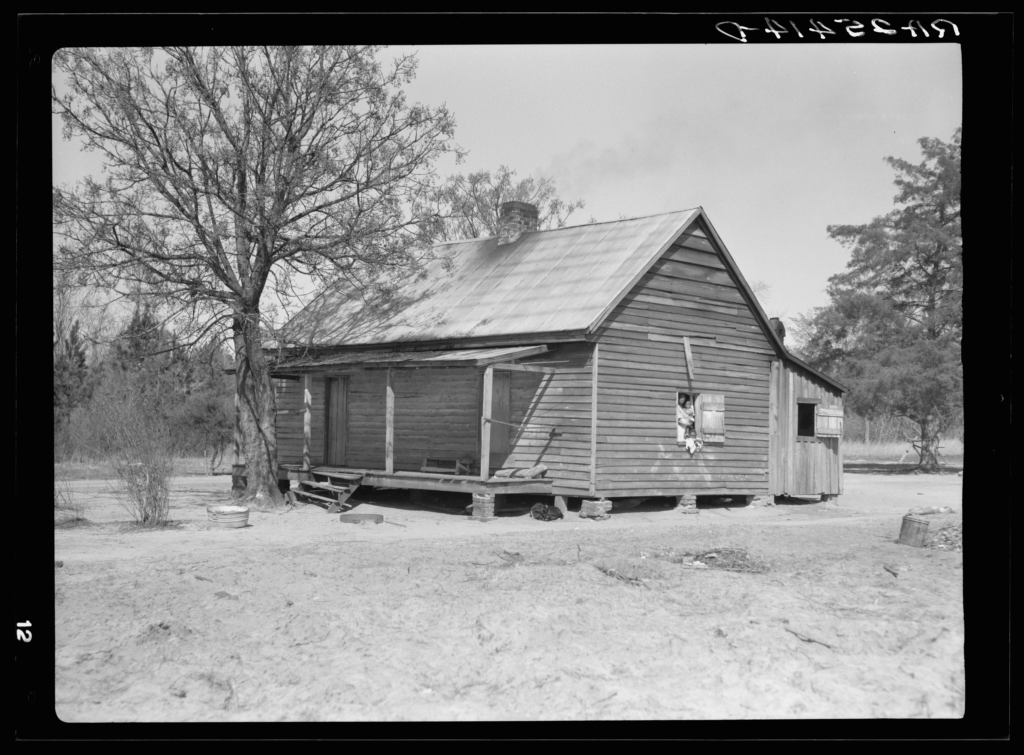
Though the era of legalized discrimination ended in the 1960s, de facto occupational segregation – and the overrepresentation of Black workers in low-wage industries – did not simply end overnight because the laws changed. Black Alabamians continue to face a range of non-legal barriers to breaking into better–paying occupations long dominated by white people,[81] including those in the auto industry. The most critical barriers include:
- Historical disinvestment in Black educational attainment, occupational training and skill building by Alabama’s state government. Since the 1970s, jobs in good–paying occupations mostly require broad educational attainment, and often specific technical skills development. Alabama historically has underfunded the public institutions that provide education and occupational training for all its residents. This in turn has disproportionately hurt African Americans, who often have fewer resources than white people do to attend college or obtain private education. All of these factors contribute to wage disparities.[82]
- Cultural hiring practices that assume certain occupational workers are supposed to look a certain way. Research suggests hiring managers often have an implicit bias that sees as white men as more appropriate for higher–skilled, higher–wage jobs (supervisors or certain technical occupations like welders), while viewing Black women as more appropriate for lower-skilled, lower–wage jobs like clerical or general labor positions.[83] In addition, Alabama’s history of legalized occupational segregation means many Black workers have no family experience or social networks with other Black people in certain occupations, which can make it harder for African Americans to see those occupations as possible for them.[84]
- Overt racial discrimination, where Black workers are paid less or given lower–paying jobs explicitly because they are Black. Though overt discrimination is illegal, it still happens from time to time in businesses across Alabama. In the auto industry, Hyundai has faced multiple allegations of racial discrimination in worker lawsuits in recent years.[85] [86] The company responded that it “provides a workplace free of discrimination” and does not comment on specifics of pending litigation.[87]
Though these kinds of challenges face Black workers across the economy, the broader history of the auto industry in the United States – especially in the Midwest – points to a better path, one not yet taken by Alabama’s auto industry. Between 1914 and 1947, Ford CEO and founder Henry Ford instituted a universal commitment to pay every worker the same wage: $5 a day for all workers in his plants, a promise of equal pay that lasted well into the 1950s.[88] Current Alabama auto plant workforces mirror the state’s longstanding economic inequities, with a higher-paid management structure made up heavily of white workers. These managers often are supervising line workers, who as a group are typically disproportionately Black workers.
In contrast to today’s Alabama auto industry, Black workers were overrepresented in Ford plants. They made 20% of Ford’s workforce in Michigan, compared to just 6% of the population.[89] Because they were overrepresented in an industry that paid equal wages, they slowly pushed up wages for all Black workers in the state, as other employers increased pay to compete with Ford. Recent research has suggested that Ford’s equal pay policy cut the overall wage gap between white and Black workers in half for Michigan workers outside the auto industry.[90] Alabama’s auto industry should make a similar commitment to equal pay, which should involve both proving equal pay for equal work within occupations and recruiting more Black workers into higher–wage occupations.

At the same time, women face a similar but specialized set of barriers to entering male-dominated occupations, rooted partly in the state’s history and partly in the challenges of life today in Alabama’s economy. Historically, occupations dominated by women paid less because harmful cultural norms perceived them as “women’s work” and lower-status than jobs more associated with men.[91] [92] The pay gap between men and women in Alabama is one of the country’s largest and has structural and systemic origins, as a recent report by the Alabama Workforce and Wage Gap Task Force found.[93] Before various waves of industrialization took off in the 1880s, women and men in Alabama (as in the nation at large) often took on more similar roles, such as working together on the family farm.[94]
Yet as Alabama industrialized over the early and mid-20th century, more men began working for pay outside of the household, leaving women to continue the unpaid work of caring for the home and family.[95] This significant shift in gender roles slowly fueled unfounded cultural assumptions that men’s work was worthy of pay, while women’s work, because it often was inside the household, was not.[96] When women began entering the workforce and working outside the home in greater numbers in the 1960s, they often earned less because of these pervasive cultural views on the role of women.[97]
Today, women still face significant structural barriers to entering higher-wage occupations and earning equal wages. These barriers include continuing overt discrimination (which is illegal under state law following the 2019 passage of the Clarke-Figures Equal Pay Act),[98] a “motherhood” penalty – where women earn lower wages because employers assume women will take time away from paid work for childbirth and raising child – and the lack of affordable child care.[99] In addition, many women of color also are held back by the same challenges facing male workers of color, and often end up siloed into the lowest-wage and least–skilled occupations.
Additional sections
 Executive summary
Executive summary
 Introduction
Introduction
 The high stakes and big bet on Alabama’s auto industry
The high stakes and big bet on Alabama’s auto industry
 The ways the bet on auto benefited Alabama
The ways the bet on auto benefited Alabama
 A wheel in the ditch: Autoworkers see falling pay
A wheel in the ditch: Autoworkers see falling pay
 A wheel in the ditch: Economic impact of falling wages and the pay gap
A wheel in the ditch: Economic impact of falling wages and the pay gap
 A wheel in the ditch: Working conditions worsen
A wheel in the ditch: Working conditions worsen
 The auto industry and Alabama’s low-road economic development approach
The auto industry and Alabama’s low-road economic development approach
 What we should do next
What we should do next
 Research design and methodology
Research design and methodology
[74] Wages for Asian autoworkers also have declined since 2002. This is likely because many executive and management positions in the early years of the industry’s presence in Alabama were held by managers from the companies’ countries of origin, such as Japan and South Korea. Over time, a larger share of those high-paying management jobs came to be held by U.S. residents of other races, particularly white managers, as the occupational siloing discussion later in this section explains.
[75] Washington Center for Equitable Growth, “Fact sheet: Occupational segregation in the United States” (Oct. 3, 2017), https://www.equitablegrowth.org/fact-sheet-occupational-segregation-in-the-united-states.
[76] Gavin Wright, Old South, New South: Revolutions in the Southern Economy since the Civil War, Louisiana State University Press: Baton Rouge (1986).
[77] C. Vann Woodward, Origins of the New South, 1877–1913: A History of the South, Louisiana State University Press: Baton Rouge (1981).
[78] James C. Cobb, The Selling of the South: The Southern Crusade for Industrial Development, 1935-1990, University of Illinois Press: Urbana-Champaign (1993).
[79] Wright, supra note 76.
[80] Woodward, supra note 77.
[81] Danyelle Solomon, Connor Maxwell & Abril Castro, “Systematic Inequality and Economic Opportunity,” Center for American Progress (Aug. 7, 2019), https://www.americanprogress.org/article/systematic-inequality-economic-opportunity.
[82] Ellen Gomory, “School choice in one of the most segregated, unequal systems in the country,” Alabama Political Reporter (April 5, 2023), https://www.alreporter.com/2023/04/05/school-choice-in-one-of-the-most-segregated-unequal-systems-in-the-country.
[83] Women’s Foundation of Alabama, Clearing the Path: Galvanizing the Economic Impact of Women (2022), https://wfalabama.org/assets/2022/05/WFA_CTP_2022_PRESSREADY_Webshare.pdf.
[84] Allan M. Freyer, Allison Forbes & Pamela Howze, “Making Youth Apprenticeships Equitable and Effective: Lessons from North Carolina,” North Carolina Justice Center (June 28, 2019), https://www.ncjustice.org/publications/making-youth-apprenticeships-equitable-and-effective-lessons-from-north-carolina.
[85] William Thornton, “Black men suing Montgomery Hyundai plant for racial discrimination: White manager was called ‘master,’” AL.com (Nov. 17, 2022), https://www.al.com/business/2022/11/black-men-suing-montgomery-hyundai-plant-for-racial-discrimination-white-manager-was-called-master.html.
[86] Nathan Prewett, “Montgomery Hyundai plant facing another discrimination lawsuit,” Selma Sun (Nov. 21, 2022), https://selmasun.com/news/montgomery-hyundai-plant-facing-another-discrimination-lawsuit/article_25e871ae-69ce-11ed-a9c5-bf7d9e354695.html.
[87] Thornton, supra note 85.
[88] The Henry Ford, “Ford’s Five-Dollar Day” (Jan. 3, 2014), https://www.thehenryford.org/explore/blog/fords-five-dollar-day.
[89] Jonathan Lanning, “How Ford Motor Company’s Equal Pay Policies Reduced Overall Labor Market Discrimination,” Federal Reserve Bank of Chicago (Aug. 2021), https://www.chicagofed.org/publications/profitwise-news-and-views/2021/ford-motor-equal-pay-policies.
[90] Ibid.
[91] Kathrin Leuze & Susanne Strauß, “Why do occupations dominated by women pay less? How ‘female-typical’ work tasks and working arrangements affect the gender wage gap among higher education graduates,” Work, Employment & Society, vol. 30, no. 5, 802-820 (Oct. 2016), https://d-nb.info/1119707552/34.
[92] Asaf Levanon, Paula England & Paul Allison, “Occupational Feminization and Pay: Assessing Causal Dynamics Using 1950-2000 U.S. Census Data,” Social Forces, vol. 88, no. 2, pp. 865-891 (Dec. 1, 2009), https://academic.oup.com/sf/article-abstract/88/2/865/2235342.
[93] Alabama Workforce and Wage Gap Task Force, “Key Findings and Recommendations of the Alabama Workforce and Wage Gap Task Force” (2023), https://wfalabama.org/assets/2023/02/Alabama-Workforce-and-Wage-Gap-Task-Force-Report-2023.pdf.
[94] Tsongas Industrial History Center, “The Role of Women in the Industrial Revolution,” University of Massachusetts Lowell, https://www.uml.edu/tsongas/barilla-taylor/women-industrial-revolution.aspx.
[95] American Association of University Women, “Systemic Racism and the Gender Pay Gap” (2021), https://www.aauw.org/app/uploads/2021/07/SimpleTruth_4.0-1.pdf.
[96] Ibid.
[97] Alabama Workforce and Wage Gap Task Force, supra note 93.
[98] Lloyd, Gray, Whitehead & Monroe, P.C., “Alabama Enacts New Equal Pay Act to Prevent Wage Disparity,” https://www.lgwmlaw.com/news-media/ALABAMA-ENACTS-NEW-EQUAL-PAY-ACT-TO-PREVENT-WAGE-DISPARITY.
[99] Alabama Workforce and Wage Gap Task Force, supra note 93.





